Color Pigeons: Characteristics, Care, and More!
Ever since the first pigeon was domesticated, more and more people have been intrigued by the idea of keeping these beautiful birds as pets.
Among the many breeds, color pigeons are considered the fancy or rare types due to their different color varieties and unique characteristics.
Some of the most popular color pigeon breeds are Ice pigeons, Thuringen, starling, etc. All of these breeds have unique coloration, such as black, blue, red, etc.
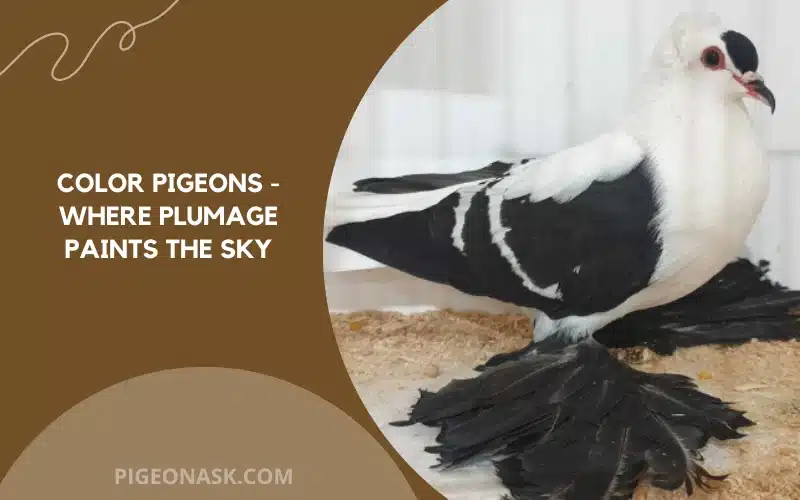
Let’s learn more about these beautiful birds.
Overview of Color Pigeons
Color pigeons are actually several pigeon breeds that have different colorations in their feathers and body parts. These colors are a result of melanin in their genes.
When in different proportions, they create these color varieties.
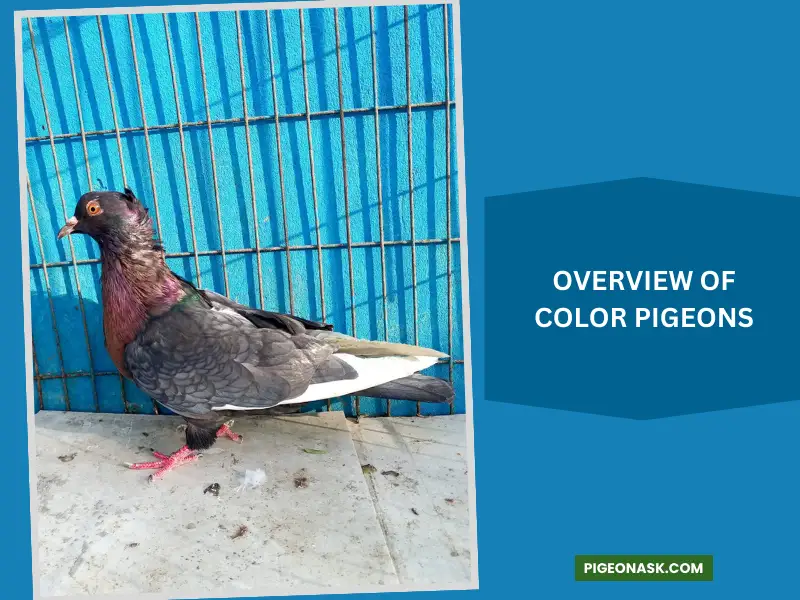
By breeding them with each other and controlling their diet, these colorations have developed. So, rather than a breed, color pigeons refer to a category with some specific characteristics.
Looking for more articles about pigeon type:
Popular Colors Pigeons
There are a variety of color pigeons available that we know of. Let’s get introduced to a few most popular and well-known ones.
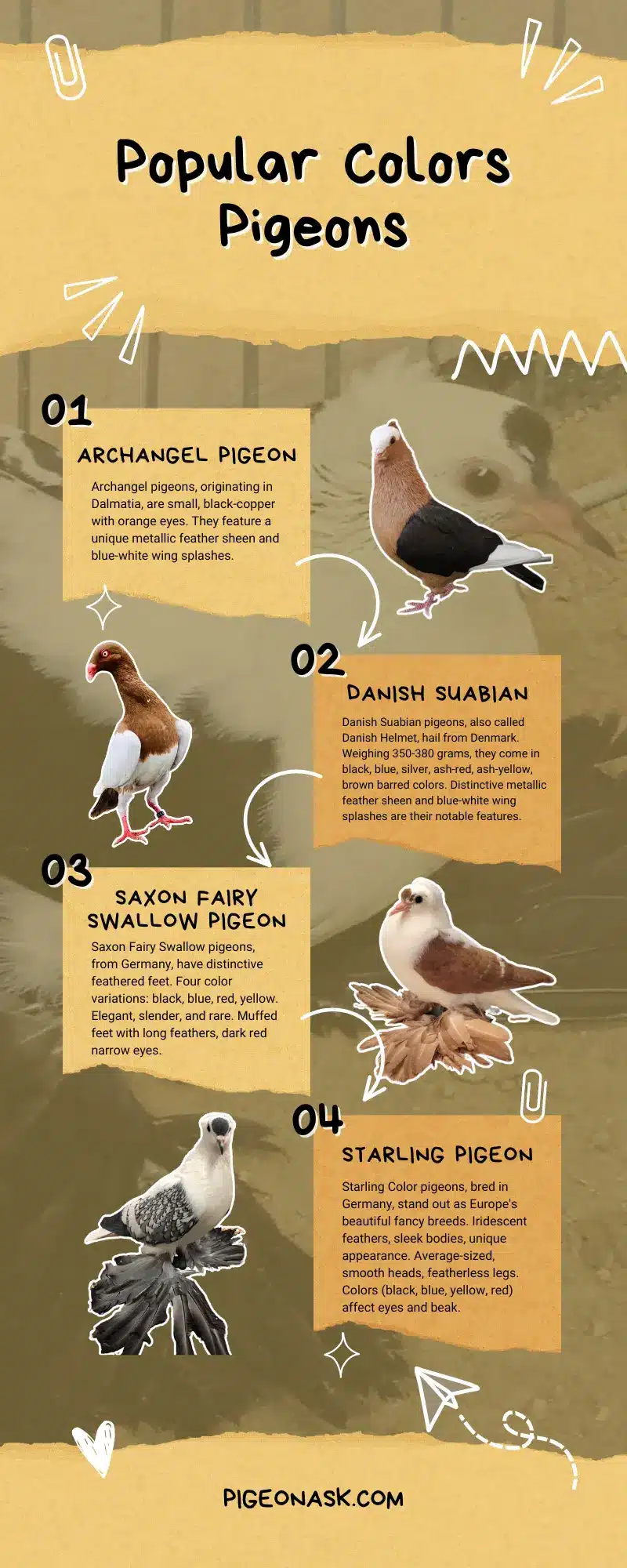
Archangel Pigeon
One of the many descendants of Rock Pigeons, the Archangel pigeon is a fancy and rare breed with an unusual yet quite beautiful appearance. This pigeon breed is a very old one and primarily originated in Dalmatia or Illyria.
Small shaped and weighing up to 10-12 Oz, they are mostly black and copper colored with dark orange eyes.
But the most known feature of this breed is the unique metallic sheen on their feathers. Besides, you can also find splashes of blue and white on the wings.
Danish Suabian
Also known as Danish Helmet, these pigeons are originally from Denmark, as the name goes.
Weighing around 350-380 grams, Danish Suabian pigeons are typically seen in black, blue, sliver, ash-red, ash-yellow, brown barred colors.
But the most known feature of this breed is the unique metallic sheen on their feathers. Besides, you can also find splashes of blue and white on the wings.
Saxon Fairy Swallow Pigeon
Because of odd feathered feet, Saxon Fairy Swallow pigeons are easily distinguishable from other breeds. Originating in Garmany, these pigeons are known for their elegant and slender appearance.
Selectively bred, Saxon fairy swallow pigeons come in mainly four color variations: black, blue, red, and yellow. This rare breed is known for its beautiful, muffed feet with long feathers.
In contrast to the bright white body, they have dark red narrow eyes.
Starling Pigeon
Also bred in Germany, Starling Color pigeons are one of the most beautiful fancy pigeon breeds in Europe.
With beautiful iridescent feathers and slender body shapes, they possess quite a unique appearance than typical domestic pigeon breeds.
They are usually average-sized with smooth heads and clean featherless legs. The color of these birds usually varies between black, blue, yellow and red. Additionally, their coloration also determines the color of the eyes and beak.
Common Physical Appearance and Unique Features
As we have already said, color pigeons are not a specific breed so they don’t have any particular appearance characteristics. The only common thing about their physical trait is that they all have unique colorations.

Two reasons why these pigeons are so colorful are because of their genes and pigments. The diet and melanins also significantly affect coloration.
Besides, they all have strong long beaks that are curved slightly at the tip. As for body shape, tall, rounded, or slender is the most common.
Let’s see what else is common in the color breeds of pigeons –
Behavior and Personality
The behaviors of color pigeons can be categorized in a few aspects, such as social, territorial, feeding, mating, etc.
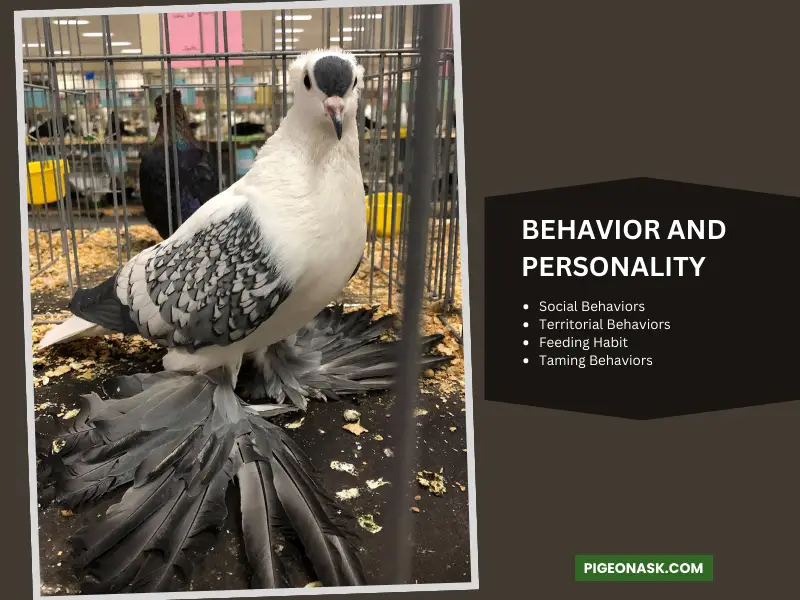
Social Behaviors:
Color pigeons are social animals, so they like to move in groups or flocks.
There are usually hierarchical relationship orders (refers to structured dominance and leadership networks, with distinct roles for social dominance and in-flight decision-making) in each flock.
But, it’s not that strictly maintained, which is quite common in bird species.
They are also seen to follow a flexible egalitarian social structure. However, it depends on different factors what type of social behaviors they portray.
Territorial Behaviors:
Usually, color pigeons are very territorial. Especially the male color pigeons are seen to defend their territory, which includes their nest and nearby tree branches.
This is also called the Perch Rights, where they mark individual territory by sitting or resting on branches at night.
Feeding Habit:
Pigeons are not exactly picky eaters, so they can eat about everything from left-out food to specialized meals. Grains, seeds, bugs, insects, rice, bread, fruits, and vegetables, you name it, and they will eat it without hesitation.
Even though they seem to roam in large groups, when facing competition regarding food, they tend to be protective. They don’t like sharing food.
Sometimes, they will even grunt and strut in order to drive away other pigeons when eating. In the wild, they usually fly in large groups to locate easy food sources.
At the same time, they need to look downwards for a long time to see and eat the food from the ground. Sometimes, while eating, wild animals like dogs, foxes, etc. prey pigeons down.
Staying in large groups helps scare away predators in these cases.
Taming Behaviors:
Color pigeons are extremely popular as pets since they are easy to tame. In a safe space under the right circumstances, they respond best to taming techniques in order to form a meaningful relationship with their caregiver.
So, the first step in taming color pigeons is to create a space where they feel protected. Using food as a reward is a very common and proven method of taming pigeons.
Feeding them regularly in a specific space will make them relate you to their food source.
Once they start to trust you, they are more likely to approach you closely and spend more time around you. They also like being held and petted by their trusted individual.
The taming process is very slow and gradual, so being patient with them is an essential factor here.
Vocalizations
The different breeds of regular and colored pigeons sound the same. They can make sounds like cooing, grunting, whistling, squawking, hissing, etc. with their throat depending on the situation.
Cooing Sound: Cooing is the most common type of sound made by color pigeons. The length and tone of it can vary depending on the purpose of it. Most of the time, they produce cooing sounds to ‘talk’ or communicate with nearby pigeons.
It’s also their mating sound or when they show affection to their partners.
Squawks and Whistles: Whistling and squawking are more common in baby pigeons since their vocal cord and throat are not developed enough to form deep cooing sounds. They make these sounds to gain the attention of adult pigeons when they are hungry or distressed.
Grunts: Grunting is more of a distress call for the color pigeons. They also produce grunting sounds to scare away predators or rivals.
Geographic Distribution of These Breeds Worldwide
Color pigeons are found all over the world. Among them, one of the most common places to find them is Germany. For example, Saxon fairy pigeons first originated in Saxon, Germany, and they have also been bred there for a long time.
Besides, Thuringian and Starling color pigeons are mostly found in Germany.
Aside from that, they are also found across Asia and Africa. Poland, Croatia, India, Japan, and China have different types of color pigeons.
Diet
Being rare breeds, most people question if there is any special food for color pigeons. The answer is no. They are not exactly picky eaters and can eat everything a regular pigeon or most pet birds eat.
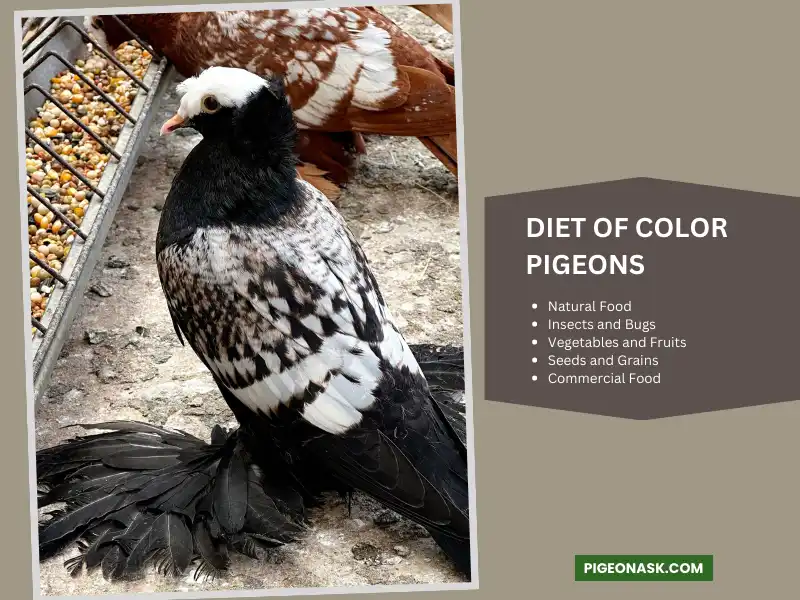
Food for these rare breeds includes natural and commercial bird food.
Some of the food, such as carrots, kale, spinach, corn, tomatoes, watermelons, etc. contains natural carotenoids, which is very important for the coloration of these birds.
In fact, it’s one of the two main pigments that give color pigeons their exotic colors. And since pigeons can’t produce carotenoids naturally, they need this food.
Natural Food: Typical natural foods for color pigeons include insects, bugs, different vegetables, fruits, etc. You can add new food to their diet, but make sure to test it out for a few days to see if they have any adverse reactions to it.
Insects and Bugs: Earthworms, spiders, beetles, worms, ants, flies, and other small insects. Insects provide protein and fat in their diet.
Vegetables and Fruits: Berries, herbs, cherries, raisins, grapes, bananas, kale, spinach, leafy greens, etc. These are usually the vegetable and fruits color pigeons can eat.
When serving large fruits, cut them into small pieces.
Seeds and Grains: Apart from insects, vegetables, and fruits, a significant part of their diet consists of seeds and grains such as grass seed, sunflower seed, corn, rice, millet, sorghum, flax, etc.
Commercial Food: Color pigeons in captivity are also fed a lot of commercial food. The most popular commercial pellet food mix consists of different varieties of seeds and grains. This mixture makes it an ideal diet for pet color pigeons.
Lifespan
The lifespan of color pigeons depends on whether they are living in a wild habitat or in human captivity as pets. In their natural wild abode, color pigeons may live up to 3-5 years.
The reason why they live such a short time in the wild is because of death by predators, common diseases, scarcity of food, etc.
However, in captivity, as pets, they can live as long as 15-20 years. Here, they are better-taken care of with sufficient and nutritious food, safety from predators, health care and medication, etc. So, it ensures a longer lifespan than in the wild.
Reproduction
Color pigeons take one mate at a time and they mate for life. In the most general case, they can breed up to 8 times a year.
The breeding behavior is portrayed by the males trying to court the females with sounds and gestures.
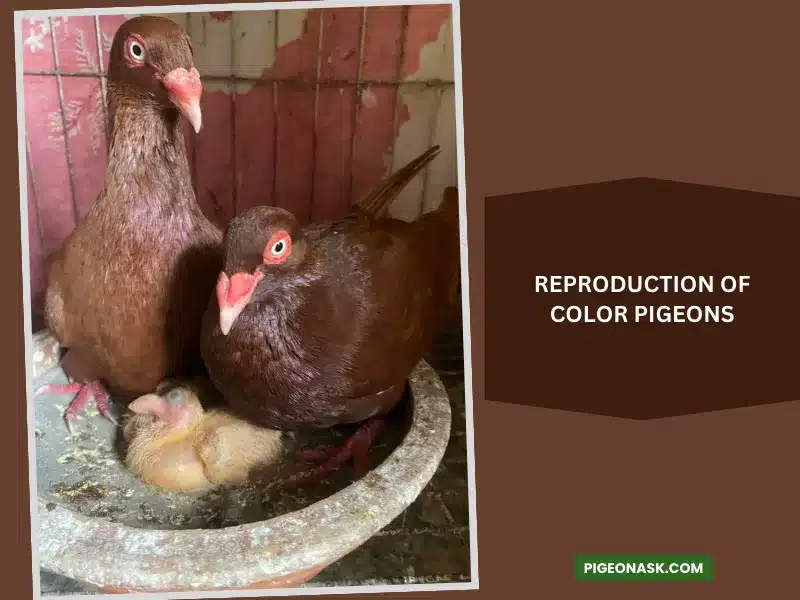
Prolonged cooing, strutting, intricate footsteps circling the female, and inflating the throat are some of the most common mating behavior among color pigeons.
Sometimes, they are also seen to present food as a courtship gesture.
Once the female has chosen their mate, they reply with soft cooing sounds.
Finally, the female pigeon crouches, helping the male to jump on the back when it’s time to mate.
Migration
Color pigeons are mainly bred for show purposes, for their looks. Where the migratory characteristics like flight power and seasonal preference were looked over. So, genetically these breeds prefer being around humans.
However, they can be seen to slightly change their habitat to nearby places if food and water are scarce.
The Popularity and Cultural Significance of Color Pigeons
Color pigeons’ popularity comes from their unique appearances and friendly characteristics. People that like pigeons in general are usually intrigued by these pigeons’ appearance and colorations.
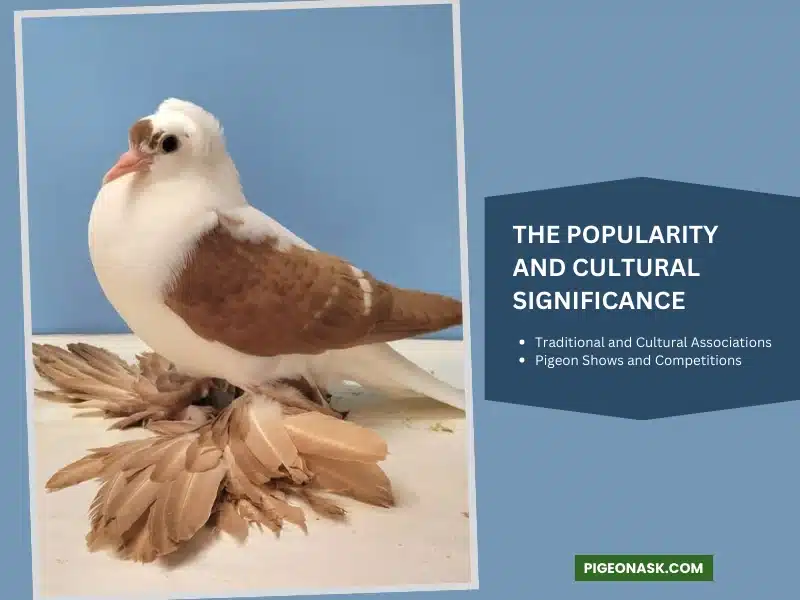
In fact, the domestication of color pigeons first started because people were interested in keeping them as pets.
Later on, there were other sectors where these pigeons were being used. Now a big part of color pigeons is used in shows and exhibitions, races, different ceremonies, etc along with domestication.
Traditional and Cultural Associations
Pigeons being associated with traditional and cultural associations goes back decades ago.
The first example we know of is releasing pigeons as a symbol of freedom in different cultural ceremonies. Apart from this, many countries have cultural and religious festivals where color pigeons are a very intimate part of it.
The different colors of these pigeons are sometimes used to portray different concepts like hope, freedom, fortune, luck, etc.
Pigeon Shows and Competitions
As we’ve already said, apart from domestication, the second biggest reason why color pigeons are bred is for different shows, exhibitions, and racing competitions.
In fact, some shows are specially arranged to exhibit different types of pigeons and their beautiful colors, unique appearances, etc.
Plus, a big part of the color pigeons are used for racing competitions as well.
Breeding and Care Tips for Colour Pigeons
Domestication of color pigeons is an unlikely concept. People like them for their unique appearances and they are very easy to tame as well.
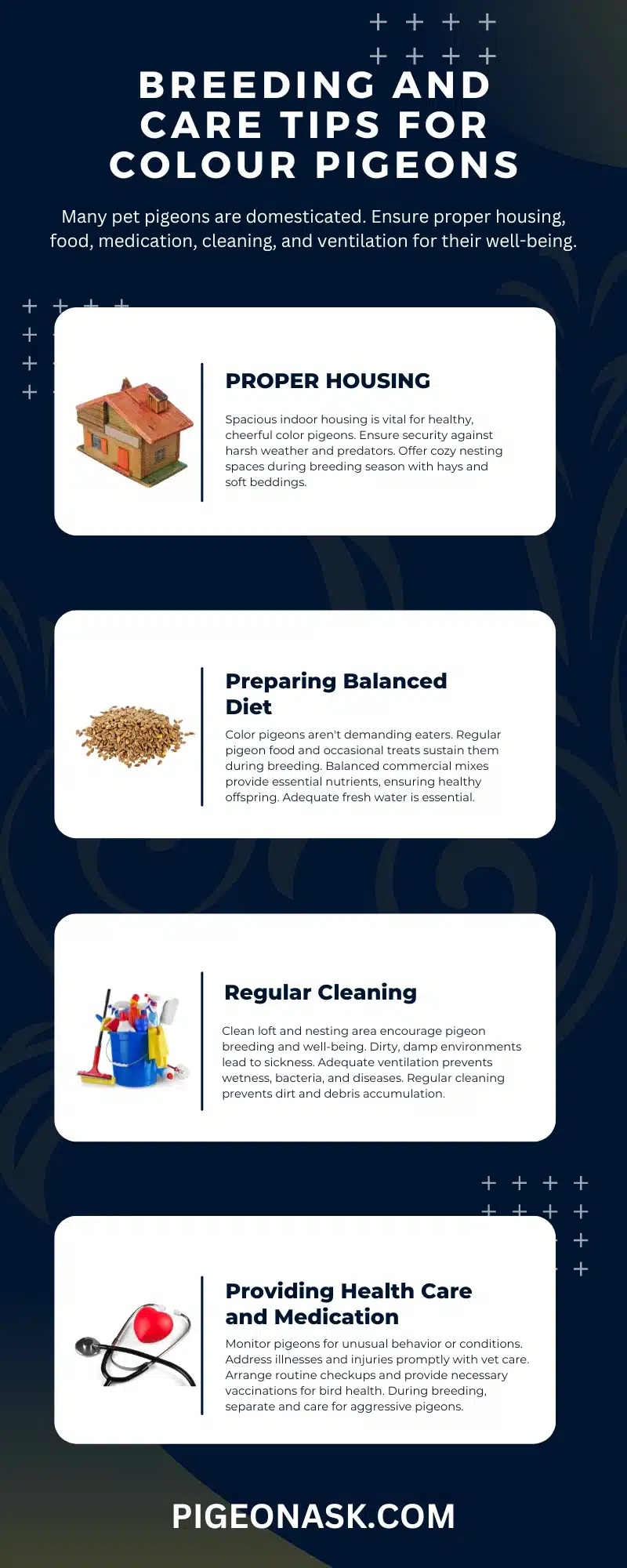
However, can these pigeons be kept as indoor pets? The answer is yes. A big part of the color pigeon population is now domesticated and kept as pets. For healthy and happy pet pigeons, you’ll need to arrange a set of things like housing, proper food, medication, cleaning, ventilation, etc.
Let’s see some breeding and care tips for your color pigeons to keep them happy and healthy.
Proper Housing
While setting up an indoor housing for color pigeons, make sure the space is spacious enough for all the members. Giving them space to move and fly around comfortably helps keep them healthy and cheerful.
But most importantly, make sure it’s secure and sturdy enough to protect them from harsh weather conditions. Pigeons are usually easy prey to different predators. So, the setup should protect them from predators as well.
Especially during the breeding season, provide comfortable nesting areas with hays, soft beddings, straw, etc.
Preparing Balanced Diet
Color pigeons are usually not needy or picky eaters. So, regular pigeon foods and some extra treats are enough to keep them strong and healthy even in the breeding period.
Commercial pigeon mixes are usually well-balanced and help provide nutrients necessary during fertilization. The proper balance of calories and protein makes sure the offspring are born with healthy bones and body parts.
Along with food, make sure to provide enough fresh water as well.
Regular Cleaning
A clean loft and nesting area encourage the pigeons to breed, so it’s important for their reproduction as well.
A dirty and damp loft is the most common reason pigeons get sick. Proper ventilation makes sure the place is dry and not wet or muddy.
Not to mention it prevents bacteria growth and diseases. And it helps keep the place clean for a long time as well. Additionally, sweep the place to clean out the dirt and debris.
Providing Health Care and Medication
Always monitor the pigeons for any unusual behaviors or conditions. Common illnesses and injuries should be taken very seriously and get checked by the vet immediately. Alongside, provide shots for common bird diseases if necessary.
The best way to ensure proper healthcare for color pigeons is to arrange routine checkups for them and constant monitoring for any signs of possible diseases.
Also, during breeding periods, some pigeons may portray abnormal or aggressive behavior. Any violent individual should be separated immediately from the group and treated with proper care.
Conclusion
These beautiful, rare, and fancy pigeon breeds are great for pets. Even for beginners, they are easy to care for, which is why most people are very interested in color pigeons.
But make sure you have gone through the basic knowledge before getting one for yourself. Hopefully, this article has helped you get a head start.
Image Credits:
- https://www.facebook.com/groups/colorpigeon/
- https://www.facebook.com/groups/222168149317472/
- https://www.facebook.com/groups/2239236702831715/
